Introduction to the case study
offered by Luis Grajal de Blasby
by Antoinette Camilleri Grima
|
|
Luis Grajal de Blas is
involved in the administration of a bilingual
programme in a Spanish secondary school, Ies Pérez
Comendador in Plasencia (BILINGUAL
PROGRAMS IN EXTREMADURA2.ppt). In this case
study he highlights a number of background variables
such as geographical, economic and social factors
that have a bearing upon the organisation, implementation,
and success of an innovative programme like this
one.
|
The Guide (Chapter 3) discusses a number of social
factors relevant to decision-making processes in education.
Grajal de Blas gives a clear picture of the many social
facets that influence the needs of the community and
the social representations of languages and language
education. This case study also exemplifies the
school profiling process and illustrates in some detail
the type of information that can be collected before
embarking on a whole-school language policy (School
profile).
The bilingual programme described by Grajal de Blas has made
a number of important efforts in order to:
- Diversify language learning activities (Guide,
section 6.5)
- Diversify materials and resources (Guide, section
6.5.1.4)
- Link with other teaching establishments (Guide,
section 6.5.4)
- Cater for staff development (Guide, section 5.4.3)
Grajal de Blas gives details of these efforts in his
case study. Finally he also makes an appraisal
of the success and challenges still facing their programme,
and how the school has moved to work hand in hand with
the local authorities in order to improve the overall
language provision (School
policy). |
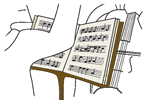 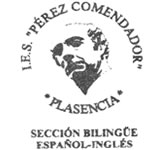 Bilingual
Programmes in Extremadura Bilingual
Programmes in Extremadura
Luis Alberto Grajal de Blas
The aim of this contribution is to describe the way we have recently
implemented plurilingualism in the Spanish region of Extremadura.
First, a background to the social and economic context is given.
This is then followed by a description of our school and an illustration
of our bilingual programme.

Geographical and Economic Background
EXTREMADURA is a western region in Spain close to the Portuguese
border. Its territory is divided into two provinces: Cáceres
and Badajoz. Table 1 presents some data related to its social and
economic background. From this information one concludes that:
- No population growth has taken place in the last century and
the population at present remains the same as in 1920.
- During the fifties, sixties and seventies of the past century
Extremadura lost a quarter of its population due to emigration,
mainly to areas surrounding the richest Spanish cities - Madrid,
Barcelona and Bilbao - but also to other countries like France,
Switzerland, Germany, and The Netherlands.
- 2.5% of the population in Extremadura live in 8.5% of the Spanish
territory (i.e. the territory of Extremadura).
- 45% of the population are either under 20 years or above 65.
- Agriculture and livestock are still very important activities
in the economy of our region.
- The annual income per inhabitant is almost 40% lower than the
average EU-25 countries.
Table 1: Social and Economic Background
|
|
FIGURES |
COMMENTS |
|
|
Demography |
Evolution
in the 20th century:
1900:
882410 inhabitants
1920:1054707
inhabitants
1950:1364857
inhabitants
1980:1050119
inhabitants.
Evolution
over a 3 year period:
2002
: 1073050 inhabitants
2003: 1073904
inhabitants
2004
: 1075286 inhabitants
Population under 20 yrs: 23,5%
Population
above 65: 19,08%
birth
rate (1/1000):9,19
death
rate (1/1000):9,59
population
growth rate (1/1000): -0,4 |
45%
of the population in Extremadura live in towns with more
than 10,000 inhabitants.
While
the population in Spain grew 108% in between 1900 and 1991,
Extremadura growth rate at this time was only
20%.
At
the beginning of the 20th century almost 5% of
the population in Spain lived in Extremadura. Now only 2.5%
of Spaniards move to our region. |
|
|
Land
Area |
41,634
Km2 |
This
amounts to 8.5% of the country.
The
province of Badajoz is the largest in Spain. Cáceres
ranks third in size.
Population
density is 25 persons/Km2 |
|
|
Employment
(2004) |
Agriculture
and livestock: 13.53%
Industry:
10.4%
Construction:
14%
Services:
62.07% |
|
|
|
Income
per capita (EU-25 = 100)
(2004) |
Spain
: 94,6
Extremadura:
61,5 |
Extremadura
is one of the poorest regions in Spain. Along with Andalucía,
it is still considered to be a priority number 1 area
by the European Union. |
|
IES PEREZ COMENDADOR is located in Plasencia,
the main town in northern Extremadura, the second largest town in
the province of Cáceres and the fourth largest one in Extremadura
with 40,000 inhabitants.
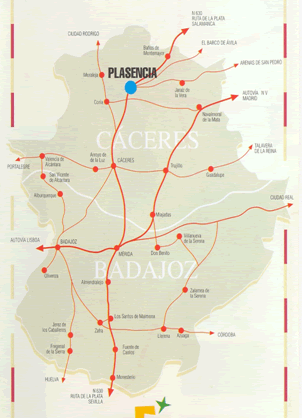 Since its foundation in 1186, Plasencia has been a crossroads, a
trading centre where products related to agriculture and livestock
are sold (the traditional weekly market organised in the main square
of the old town is a symbol of this activity). Plasencia is also
a reference point for people coming from the surrounding area due
to the availability of hospitals, schools, a University and other
services. Within its Medieval walls, people can find some of the
most prized monuments in Spain. Palaces, Romanesque
and Gothic churches, two cathedrals (the older inside the new one)
are the main buildings of this historic environment. In its coat-of-arms,
the town motto reads UT PLACEAT DEO ET HOMINIBUS (to please God
and mankind). The university city of Salamanca is 130 km from
Plasencia, and Madrid is about 230 km eastwards.
Since its foundation in 1186, Plasencia has been a crossroads, a
trading centre where products related to agriculture and livestock
are sold (the traditional weekly market organised in the main square
of the old town is a symbol of this activity). Plasencia is also
a reference point for people coming from the surrounding area due
to the availability of hospitals, schools, a University and other
services. Within its Medieval walls, people can find some of the
most prized monuments in Spain. Palaces, Romanesque
and Gothic churches, two cathedrals (the older inside the new one)
are the main buildings of this historic environment. In its coat-of-arms,
the town motto reads UT PLACEAT DEO ET HOMINIBUS (to please God
and mankind). The university city of Salamanca is 130 km from
Plasencia, and Madrid is about 230 km eastwards.
In a single day one can visit Roman ruins in Caparra, the Medieval
Jewish quarter in Hervás, a palace of the Habsburg Emperor
Charles V in Cuacos de Yuste, Ski runs in Béjar, beautiful
countryside in The Jerte Valley (also known as The Cherry Valley)
and the Natural Park of Monfragüe (the largest area of Mediterranean
forest in Extremadura). These are all in the vicinity of Placencia.
The Social Context
Plasencia, like the rest of the Extremadura region, is a monolingual
area for a number of reasons:
- There are no ethnic minorities and the number of immigrants
coming to this region remains small. Multiculturalism does not
exist in our social context yet. Almost all our students are Spanish
and born within the region.
- Although our city is not far away from Portugal, no linguistic
influence comes from this country: the Portuguese language is
offered as a foreign language only in 5% of the schools. Some
programmes have been developed during the last years aimed at
increasing exchanges between the two countries.
- Our economic structure, traditionally based on local agriculture
and livestock, has little or no influence outside the region,
so that foreign languages are not considered a priority by the
population. Schools have to make a lot of effort to convince students
of the importance of foreign language teaching as there is little
or no awareness of languages among the population.
- The Spanish language is spoken everywhere. There are some dialects,
with Portuguese and Galician influences, in small rural areas,
but not with many speakers. The authorities have supported programmes
aimed at furthering knowledge about these linguistic varieties.
Tables 2, 3, 4 and 5 below provide figures that can help us understand
some facts about education in our region:
- Pre-University Students. There is a slightly decreasing trend.
17.2% of the population and 3 out of 4 people under the age of
20 attend these educational levels.
- Pre-University Student distribution among different educational
institutions in Extremadura (2004/05): Only half of the students
in compulsory education manage to reach upper secondary education.
Education is not a priority among our youth.
- Multiculturalism does not exist in our educational context:
Only 2% of students in pre-university educational institutions
come from foreign countries. Students who belong to Minority communities
require a good knowledge of the Spanish language in order to integrate
into our educational system.
- 80% of the students in pre-university studies attend public
schools.
- The number of students per group ranges between 20 and 25. The
teacher-student ratio is 1:8 in primary and 1:12 in secondary
schools.
Table 2:
|
2000/2001 |
2001/2002 |
2002/2003 |
2003/2004 |
2004/2005 |
|
197,220 |
193,377 |
190,007 |
186,718 |
185,207 |
Table 3:
|
EDUCATIONAL
LEVEL |
|
|
Pre-Primary
and Primary school |
54.15% |
|
Lower
Secondary education (Compulsory) |
30.77% |
|
Upper
Secondary Education: Academic Branch |
9.68% |
|
Upper
Secondary Education: Vocational Branch |
5.40% |
Table 4:
| EDUCATIONAL
LEVEL |
|
| Pre-Primary and Primary
school |
2.0% |
| Lower Secondary education |
1.60% |
| Upper secondary Education: Academic Branch |
0.60% |
| Upper secondary Education: Vocational Branch |
1.00% |
Table 5:
| |
Public
Schools |
Private
schools |
| Pre-Primary and Primary
school |
17.5 |
23.0 |
| Lower Secondary education |
24.3 |
28.0 |
| Upper secondary Education: Academic
Branch |
21.6 |
24.5 |
| Upper secondary Education:
Vocational Branch |
20.0 |
20.0 |
Table 6:
| |
public |
private |
| Pre-Primary and Primary
school |
415 |
Not available |
| Secondary schools |
127 |
Not available |
| TOTAL |
542 |
53 |
PEREZ
COMENDADOR SECONDARY SCHOOL
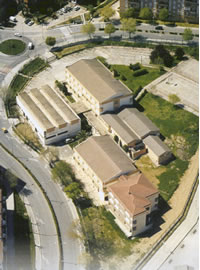 PEREZ
COMENDADOR secondary school is one of five secondary education centres
in the town. PEREZ
COMENDADOR secondary school is one of five secondary education centres
in the town.
 Up
to 1995 it was only a vocational training school but ten years ago
it became a medium sized secondary school with a new academic offer
that included both lower (compulsory) and upper secondary education.
At the beginning of the 2005-06 academic year, the school launched
an English-Spanish bilingual programme aimed at improving the linguistic
skills in both languages of the students at lower secondary level. Up
to 1995 it was only a vocational training school but ten years ago
it became a medium sized secondary school with a new academic offer
that included both lower (compulsory) and upper secondary education.
At the beginning of the 2005-06 academic year, the school launched
an English-Spanish bilingual programme aimed at improving the linguistic
skills in both languages of the students at lower secondary level.
In 2003 the school celebrated its 25th anniversary. The name comes
from a famous sculptor born at the beginning of the 20th century
in Hervás, a town not far away from our city.
Table 7 presents some figures about our students and staff. More
detailed information about the linguistic background of teachers
is given in Table 8. After analysing the data in Table 8 one becomes
aware of an obstacle identified in section 6.2.2 of the Guide: that
of the availability of teachers who can teach in two different languages.
The lack of teachers to develop plurilingualism has its origin in
the way languages were learned in Spain in the past as well as the
monolingual context in which our daily lives develop. In our school,
as in the vast majority of secondary schools in our area it is not
possible to find the right teacher profiles as described in section
6.2.3 of the Guide.
Table 7:
| GRADE
or CATEGORIES |
NUMBER |
| Lower secondary
education |
200 |
| Upper secondary education
(Academic branch) |
105 |
| Upper secondary education
(Vocational training) |
220 |
| Teachers |
64 |
| Administrators, cleaners and janitors |
11 |
Table 8:
| TOTAL
NUMBER OF TEACHERS |
64 |
| University degree
in at least one foreign language |
6 |
| University degree in
classical languages |
1 |
University studies
abroad (different from Foreign languages
ones) |
3 |
Skills in at least
one foreign language (equivalent to B1
and B2 levels of the Common European Framework
of
Reference). They have certificates issued by
well-known
institutions in foreign language teaching. |
10 |
Other official Spanish
languages speakers
(Galician, Catalonian, Basque) |
2 |
Our school is committed to a number of educational activities,
butmost of them are conducted in Spanish. Our students are
encouraged to take part in Literature Workshops (where well-known
Spanish writers explain and share with them their creative
process), Image and Sound workshops (our school produces short
films every year, often prize-winners in national contests),
cross-curricular projects on topics like drug addiction, gender
equity or multicultural society), drama activities, environmental
programmes, and Gender Equity and Coeducation, Blood Donation
campaigns (campaigns which have won regional education authority
awards).
A school magazine called CARPE DIEM is designed and made in PEREZ
COMENDADOR SCHOOL. Two or three numbers are issued yearly free of
charge for school students and teachers. Students are encouraged
to contribute by writing articles, comments and producing art work.
This magazine has a high profile in the region. It includes articles
and sections written in English and French.
Diversifying Language Learning Activities. A review of
the facts that must be considered to develop plurilingualism according
to section 6.1 of the Guide.
Our work in providing students with foreign language education
is largely influenced by the circumstances described above: the
economic and social context, the monolingual environment, traditions,
the lack of foreign language training programmes for prospective
teachers in the past, etc. (see section 6.1 of the Guide).
In the Spanish Education System all students at secondary level
(except those engaged in vocational studies) must follow courses
in at least one foreign language (90% of them choose English) across
the different levels: three lessons a week (about 100 hours per
course). A second foreign language can be learned as an option in
both compulsory and non-compulsory secondary schools (about 70 hours
per course). In our case, only 20% of the students follow a second
foreign language programme (mainly French). Those who wish to learn
German, Italian, Portuguese, etc must follow courses outside the
school system. In some cases there is no availability of learning
programmes devoted to these languages there either.
Most of our students have studied a foreign language (normally
English) for at least four years in primary school. However,
very few of them would have had the chance to visit foreign countries
or to establish contact with people from the target language countries
and cultures.
Only about 15% of our students follow foreign language courses
outside school in order to improve their communicative skills, enhance
their school qualifications, and get external certificates offered
by English, French or American institutions. There is little or
no coordination between these establishments and the school as recommended
in section 6.3 of the Guide.
DIFFICULTIES ENCOUNTERED IN FOREIGN LANGUAGE
TEACHING: THE EXAMPLE OF ENGLISH.
In our language education we deal with the four language
skills. Oral comprehension is developed by means of conversation.
For Reading comprehension, students are presented with texts (authentic
or semi-authentic), in which they can read about, among other things,
English traditions and customs, scientific facts, historical aspects,
the life of adolescents in other countries, etc. The study and enrichment
of vocabulary is fully related to the reading texts and to the conversation
themes. Oral Communication is developed by encouraging students
to communicate their ideas about a chosen topic.
The main difficulties our students encounter are related to the
structural and pronunciation differences between Spanish and English.
For instance, syllable structure is different and causes problems
in listening tasks. Grammar is considered by our students
as the most important issue in learning a foreign language so that
a great amount of time is dedicated to it. This takes away
time that could be dedicated to the strengthening of other skills
and the application of other methods (like those considered in section
6.6.1 of the Guide).
Finally the lack of contact with English speaking people (learning
in homophone environment - section 6.5.1.3 of the Guide),
the difficulties found in the lack of daily use of this language,
and the monolingual background of the students, account for a lack
of motivation on their part to learn English.
Perhaps our education system has failed to develop language awareness
programmes among the youngest learners in order to help them appreciate
plurilingualism, and to stimulate them to seek further knowledge
about linguistic varieties.
BILINGUAL PROGRAMMES IN EXTREMADURA
In the school year 2004-2005 our Regional Education Authority
launched a two year experimental bilingual programme in four lower
secondary schools, located in the two main cities of Extremadura
(Cáceres -86,000 inhabitants- and Badajoz -135,000 inhabitants-).
Two of them were French-Spanish bilingual programmes, while the
other two were English-Spanish ones.
At the beginning of the scholastic year 2005-2006, the extension
of this programme to other towns was considered. In fact, six new
schools joined the project last September, amongst them PEREZ COMENDADOR
school. Three different possibilities were offered to schools in
order to develop a bilingual programme: French-Spanish, English-Spanish
and Portuguese-Spanish sections. PEREZ COMENDADOR School went for
the second option and is now working in close cooperation with a
primary school in the city EL PILAR that launched a similar programme
with students aged 10.
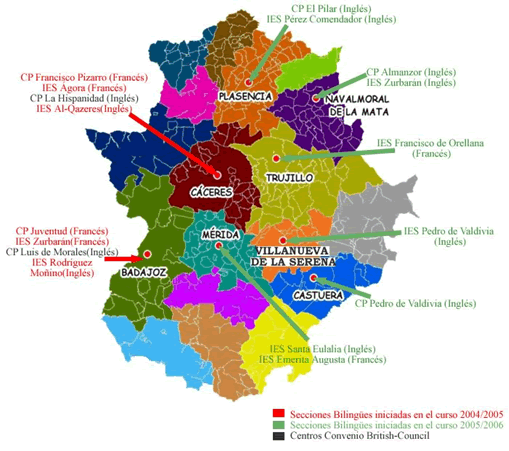
THE AIMS OF THE BILINGUAL
PROGRAMMES IN OUR REGION
The aims of our bilingual programme are:
- To improve the communicative skills of students in one foreign
language.
- To teach non-language content in a foreign language.
- To provide opportunities for cultural immersion in target language
countries.
- To reinforce the learning of a second foreign language.
- To increase exchange programmes and promote communication between
schools in Extremadura and others abroad.
- To follow European Union and Council of Europe advice on reinforcing
foreign language tuition.
We are trying to follow some of the suggestions made forward in
the Guide. For example:
- In section 6.4 it stresses the need to decompartmentalise language
education and integrate language teaching in a cross-curricular
approach.
- Section 6.5.3 describes the possibility of developing these
programmes as a pilot scheme in secondary compulsory education
just as is being done in Extremadura.
- The role of transversality in learning experiences is emphasised
in section 6.6
- In section 6.10, bilingual programmes are described as one of
the most effective ways of implementing education for plurilingualism
and plurilingual awareness.
THE STRUCTURE OF THE PROGRAMME
Our programme is intended for students who have just left primary
school and who are entering lower secondary studies at the age of
12. Two non-language subjects can be taught using the foreign
language in the bilingual programme. In our case this is done through
English. This programme tries to fulfil two roles: that of developing
students" plurilingualism and also their capacity in the area
of language awareness (as is described in section 6.10.2 of the
Guide).
In each non-language subject included in the programme, the foreign
language must be used for at least one weekly period. The syllabus
of these subjects remains the same as the one followed in other
schools which are not bilingual.
In this programme students must study a second foreign language
(in our case, French) with an additional period per week (3 hours
per week instead of 2). This decision was taken in order to promote
and develop second and foreign language learning (section 6.4 of
the Guide).
STUDENTS
Students volunteer to take part in the programme and no previous
experience in bilingual programmes is required. Schools developing
these projects are allowed to establish selection procedures in
order to incorporate students in the bilingual programme.
Parents sign an agreement on behalf of their children stating that
they will stay in the programme for two years.
At least twenty students are required to begin a bilingual project.
Only a single bilingual group is allowed in each level in every
school involved in the programme.
TEACHERS
Teachers taking part in this project are staff members of the school.
They agree to participate for a two-year period with no extra payment.
Instead they are rewarded with some benefits like a reduction in
their teaching load and grants (to attend foreign language courses
mainly). To participate in the bilingual English programme they
must have an adequate level of English which means that they either
possess a university degree in the foreign language or external
certificates issued by other institutions (e.g. Cambridge University
Proficiency Test, Spanish School of Languages, DELF (Dîplome
élémentaire langue française), etc.
Among the teachers involved in the programme there is a coordinator,
whose speciality must be the foreign language of the programme.
This teacher is in charge of the programme, coordinates the teachers'
work, looks for resources and acts as a public relations officer
in the community. Coordinators responsible for organising courses
aimed at improving the linguistic skills of the school staff members.
Teaching teams (the Guide, sections 6.2.3, 6.4.6.5.2), are one of
the main features of this kind of programme: the work load is shared
among the different staff members and foreign language teaching
is diversified.
SUPPORT FROM AUTHORITIES
Schools involved in this bilingual programme are provided with
a full time native assistant teacher (one of the specialised teachers
described in section 6.2.3). They are also funded with an extra
amount of money and have priority in the development of European
projects such as those included in Socrates Actions (Comenius, Arion,
etc.). This is a way of emphasising the importance of foreign
language learning and it is done through the establishment of educational
networks with schools abroad, and study trips. Teachers engaged
in the project are encouraged and supported when they wish to improve
their language skills abroad and are given other incentives so as
to move forward in their professional career.
ACTIVITIES DEVELOPED IN THE BILINGUAL
PROGRAMME AT PEREZ COMENDADOR SCHOOL
As previously mentioned the programme began in our school last
September (2005-2006). Since that moment the teachers involved in
the project have been working in a number of fields that will be
described below. We are also about to embark on other activities.
1. The organisation of teaching and learning activities of students
enrolled in the bilingual group (English-Spanish) in two non linguistic
areas (Mathematics and Design & Technology) and the development
of methodological tools to integrate the English language into these
subjects.
- During this first year, our priority in non-language subjects
with respect to the foreign language was the development
of oral fluency, the acquisition of vocabulary in
each field, and the consolidation of basic grammatical structures.
- Among the methodological tools we investigated the integration
of native assistant teachers in our daily work, and we also tried
to include similar content in the English lessons as in the non-language
subjects.
- Adapting the existing syllabus to the new learning conditions.
- Consolidating the communicative teaching methods as described
in section 6.6.1 of the Guide.
2. The preparation of material and the collection of resources
(printed material, multimedia, etc.)
- Textbooks borrowed from other education systems were not suitable
for our students due to the language used in them and the
differences existing between our syllabus and theirs. So
we had to work very hard in order to adapt both the syllabus and
the textbooks (see section 6.4 of the Guide).
- We consider spoken interaction in the foreign language as a
very important element and this has meant very hard work in searching
for interactive material that was in some way similar to our syllabus.
In this respect we have shared information with other schools
involved in the programme and through the Internet we have been
able to collect a significant number of resources suitable for
our students and relevant to our curriculum.
- We have translated our school web page into English, and this
has provided opportunities for new kinds of language learning:
distance learning, and self-directed learning (sections 8.5.1.4
and 6.5.1.5 of the Guide).

3.
The production of school identification cards and notices in English
and Spanish, as well as the promotion of the Programme in Plasencia
and its surroundings. Throughout the year the teachers involved
in the programme have taken on the task of explaining its objectives
and activities in primary schools, on local TV channels, magazines,
papers, etc. This was necessary in order to give it a high profile
and to emphasise the importance of plurilingualism in the context
of students" future academic careers and a modern inter-connected
world.

4. The organisation of courses for school teachers who might join
the project in the near future.
- During the first two terms of the academic year a teacher training
programme has been developed by the coordinator of the programme
together with the native assistant teacher. The programme's
aim was to update the knowledge of the English Language among
teachers who are not yet involved in the programme but who will
eventually join it. The course was held for three hours a week
over a period of five months. The plurilingualism of our teachers
is a priority for us.
5. Establishing a co-operation strategy between the native speaking
teacher and the other teachers. Native teachers are considered as
an important asset in plurilingual education.
- For most of the teachers involved in this experience, working
with a native teacher was appealing, but also demanding on their
time considering we did not have any previous experience and so
we had to struggle to find the best ways of making the best of
this possibility. Among other things, weekly periods
are devoted to the preparation of lessons, to the development
of our own pronunciation, to the development of resources, and
to the integration of content and culture of the target language.
6. The definition of a common set of communicative strategies,
vocabulary and grammar for both language and non-language subjects
taught in English. Given that our students did not have any
previous experience of learning content through a foreign language,
we agreed to establish a basic set of communication strategies in
the classroom.
7. Visits to secondary schools with previous experience in the
programme to learn about strategies for admitting students to the
programme, methodological issues in bilingual teaching and learning
processes, as well as resources and materials, assessment tools,
and new ways of increasing the partnership with the local community,
among others.
8. The establishment of cooperation between our school and the
primary education centre that is developing a bilingual experience
in Plasencia. A special link has been made with the primary
school in our town which is providing content teaching in two subjects
through English. Meetings are periodically held between the
coordinators who share resources and material. The primary
school teachers are invited to take part in our training course
with the native assistant teacher. These are some of the ways
of forging longitudinal co-ordination between language teaching
establishments (the Guide, sections 6.3, 6.5.4)
9. Strengthening the EU-dimension by learning about and participating
in European programmes and linking up with European partners.
The main aim of this work is to improve our students" communication
skills. In view of this, we plan to take part in meetings
organised by the European Union for prospective project partners;
we have published a leaflet in English about our school, its activities,
its surroundings, the staff and our students; and we have established
contacts with Spanish education advisors in other countries as a
way of finding partner schools.
10. The development of an international collaborative project
by students on traditions and cultural topics using ICT resources.
Its aim is to exchange cultural information as well as to
establish links with schools and students from different countries.
This was a direct result of the ENSEMBLE workshop held in
Graz on December 2005. Schools from Romania, Malta, Croatia
and Spain took part during this academic year (2005-2006)
(Network x4)
Thanks to this project the students of these schools have
used English to communicate, and have passed on information
about monuments, traditions, food, music, etc (resource
1 Spain.pdf; resource
2 Spain.pdf: resource
3 Spain.pdf).
Projects like the one described above allow us to develop language
learning in an interesting way despite the homophone environment
(section 6.5.1.3 of the Guide), and to integrate intercultural
aspects in our daily work (section 6.6.2.1 of the Guide)
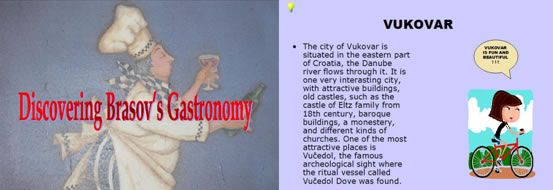
11. We have made an effort to be in touch with organisations and
institutions involved in bilingual education: English-speaking countries,
Embassies or cultural centres hosted in Spain, The British Council,
private organisations which usually develop language training programmes
abroad for students and teachers, etc.
12. We have tried to encourage other school members to contribute
in the teaching and learning of more subjects using English as a
vehicular language. This is a way of broadening the programme
to other educational levels.
13. Linking in-school with out-of-school activities such as: trips,
guided cultural tours, games, music, cultural contests etc.

We think it is important not to restrict our programme to the school.
We believe it would be beneficial for everyone concerned to extend
it to other groups of students and to activities outside the school.
This is the reason why we have proposed activities connected with
the English Language and culture in which all the students could
take part, such as a comic play in English, a fashion show related
to English culture, a treasure hunt activity in an old town where
a number of tasks in English were assigned to students in order
to improve their skills in English while they learn more about the
history of Plasencia, etc. Language teaching and learning
must be connected to the personal interests of those who are following
the training process according to specifications proposed in section
6.6.2.5 of The Guide. Leisure activities are a way of stimulating
language learning among secondary school students.
14. We are considering the possibility of implementing the European
portfolio in close cooperation with the school staff teaching languages.
This would promote self-assessment, stimulate language awareness,
and would help students establish links between different linguistic
varieties.
POSITIVE OUTCOMES OF OUR BILINGUAL PROGRAMME
- The schools involved in the project have acquired a better profile
and have been accorded higher status by the local community.
- Parental commitment to their children"s education and
school is high for students taking part in the bilingual programme.
- The assistant native teacher provides invaluable help to other
staff members involved in the project, for example in materials
development, in looking for resources, and in their own language
proficiency.
- At the end of the first year of bilingual teaching, students
performed better in oral communication in English and also showed
improvement in the non-language areas included in the programme.
- There has been a greater international dimension, better knowledge
of English speaking countries and their culture, and a better
understanding of the world situation.
- Group work and a multidisciplinary approach have been strengthened
as a result of this project.
ROOM FOR IMPROVEMENT
- There is a dire need for more printed educational resources
in non-language subjects taught through a foreign language.
- The funding for schools involved in the programme needs to be
revised in order to allow for an increase in activities and for
acquiring educational materials suitable for this programme.
- The need to strengthen teacher training programmes in foreign
languages in order to increase the bilingual education offer (both
in subjects and levels).
- The promotion of links between schools engaged in this kind
of project in order to share experiences, materials, methods,
outdoor activities, etc.
CONCLUSION
The current two main goals of the Education Authorities in Extremadura
are the spreading of ICT in schools, and the strengthening of foreign
language learning. Bilingual programmes are not the only action
proposed by education authorities to improve foreign language tuition
in our region and reverse the situation described at the beginning
of this contribution. For example, a first foreign language has
become a part of the education of three-year-old children since
2003-2004. Nowadays, at least 20% of primary schools offer
a second foreign language (two periods a week) for higher level
students (10-11 year olds). Furthermore, this academic year three
primary schools in the region are implementing the European Portfolio. |